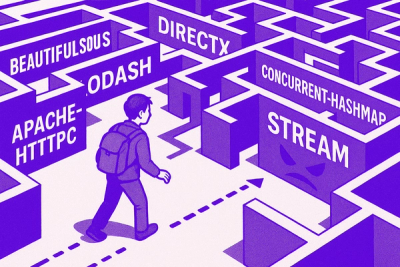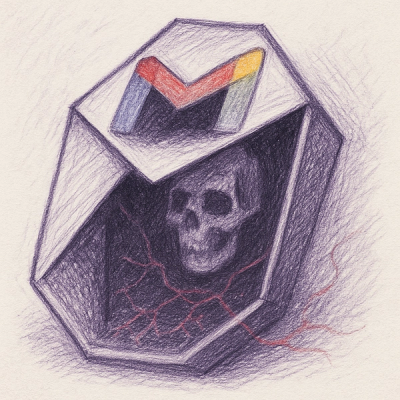
Research
NPM targeted by malware campaign mimicking familiar library names
Socket uncovered npm malware campaign mimicking popular Node.js libraries and packages from other ecosystems; packages steal data and execute remote code.
Mindmap is a tiny framework to render and browser a graph like structure, assuming you have set of simple classes that are related to each other.
The following is the example project to browse file system, generated when issuing "mindmap new" command, and contains 2 nodes (File, Directory)
It started with another project I'm working on called rubrowser it statically analyze your ruby code and visualize it in a graph, I thought that this kind of data (tree/graph like) is everywhere, like my servers, that I can see files, processes and other open sockets on it, through it I can open another server in my network, browse through it, open a process there...and so on.
Or Imagine how many times you went to Wikipedia and you found yourself on a page and you can't remember what made you land here after couple hours of reading.
so I wanted a setup that does the following:
At first I thought of D3 and visualizing these nodes and make it interactive, but I had to discard this idea as visualizing nodes in different forms will be extremely hard for users, not to mention the graph will be very crowded.
So I settled on a page that renders the root node children first, then when you try to open a node, I append children to the page and the path goes on endlessly, you can scroll back at any time and open another node it'll clear every thing under it's level then showing you the node children...and so on.
Install it with
$ gem install mindmap
First create a new project, like you do with rails
$ mindmap new hello
That will create a new directory hello with some skeleton in it.
example/
├── config.ru
├── Gemfile
├── nodes
│ ├── directory_node.rb
│ ├── file_node.rb
│ └── root_node.rb
└── public
3 directories, 5 files
it's a rack application you can start it by rackup or
$ mindmap server
the project contains an example nodes to browse the file system content, you can
start the server and open http://localhost:9292 in your browser to see it in
action.
a tutorial could be found in the wiki here
mindmapclass_name.html.erb format or other formats
wanted like class_name.json.erb or similarthe nodes directory holds your nodes, they're all loaded by default when
starting the mindmap server, the following is a commented example for a node class
# a node class name MUST end with "Node"
class DirectoryNode
# node class MUST include the Node module
# it include methods to render the node and
# an initializer for the class
include Mindmap::Node
# you can define attributes/member variables as you wish
# if you're using one of the library views you'll need to defind
# a specific methods to make it works
attr_accessor :path
def name
File.basename(path)
end
# it must return an array of other nodes that this node is related to
def children
Dir
.entries(path)
.sort
.reject! { |file| ['.', '..'].include?(file) }
.map { |file| child(File.expand_path(file, path)) }
end
private
def child(file_path)
return DirectoryNode.new(path: file_path) if File.directory?(file_path)
FileNode.new(path: file_path)
end
end
when you start the mindmap server, it loads all library code then loads the project nodes, it serves files from library public and project public directories.
when browsing to localhost:9292 it'll serve the public/index.html which is
an empty page that load jquery and bulma css framework and
public/assets/index.js
index.js is what does the interaction part of the page, it request the root
node, so your nodes directory must contain that class, mindmap will handle the
request, creating RootNode object giving it all parameters sent with the
request as a hash, Mindmap::Node#initializer will assign any key value to the
object if the key= method is public, then mindmap will call the node children.
for every child we'll render it and return the result to the page, the page will
append the response, then wait until you click on any link that refer to a local
page, when you do it'll handle the request, will request the link content with
Ajax sending the data-params of the link as parameters to the Ajax POST
request.
mindmap will know the node from the page, for example requesting /file will
signal mindmap to create a FileNode object with the passed arguments,
/directory/specific_dir will create a Directory::SpecificDir object...etc
the renderer will get the view name by calling view method, then search for a
file in the project nodes directory, when
found it'll be rendered as an ERB template with the node as a bounding context,
so any method called in the view will be executed from the node.
any link that points to a URL that starts with '/' is considered an AJAX link
and mindmap JavaScript will call the URL with a post request passing the
data-params attribute as parameters in the request, so it's a good idea that
you set some hash there that when gets assigned to the object it'll tell him
what to do, an ID in most cases, or for our example nodes the file path, for
others maybe UUID, by default the views will serialize the object as JSON and
put it in the attribute, you can be selective with your views implementation if
you wish, also data-children-title attribute is used by the mindmap JavaScript
to use it as a title for the response when appended to the page, it's a good
idea to print the node children_title in it.
every graph must have an entry point, RootNode is our entry point, this nodes
doesn't have to have any views, an object is created from that class when the
page loads, and the children will be called an rendered, so the node itself
doesn't have to do anything but implementing children method returning an array
of nodes to start with.
Mindmap doesn't have a hot reload feature, so if you want to change your code then see the changes without restarting your server manually you can use reflex or any other tool that executes a command on files change, with reflex you can use this command
$ reflex -s rackup
or
$ reflex -s mindmap server
Bug reports and pull requests are welcome on GitHub at https://github.com/emad-elsaid/mindmap.
The gem is available as open source under the terms of the MIT License.
FAQs
Unknown package
We found that mindmap demonstrated a not healthy version release cadence and project activity because the last version was released a year ago. It has 1 open source maintainer collaborating on the project.
Did you know?

Socket for GitHub automatically highlights issues in each pull request and monitors the health of all your open source dependencies. Discover the contents of your packages and block harmful activity before you install or update your dependencies.

Research
Socket uncovered npm malware campaign mimicking popular Node.js libraries and packages from other ecosystems; packages steal data and execute remote code.

Research
Socket's research uncovers three dangerous Go modules that contain obfuscated disk-wiping malware, threatening complete data loss.

Research
Socket uncovers malicious packages on PyPI using Gmail's SMTP protocol for command and control (C2) to exfiltrate data and execute commands.